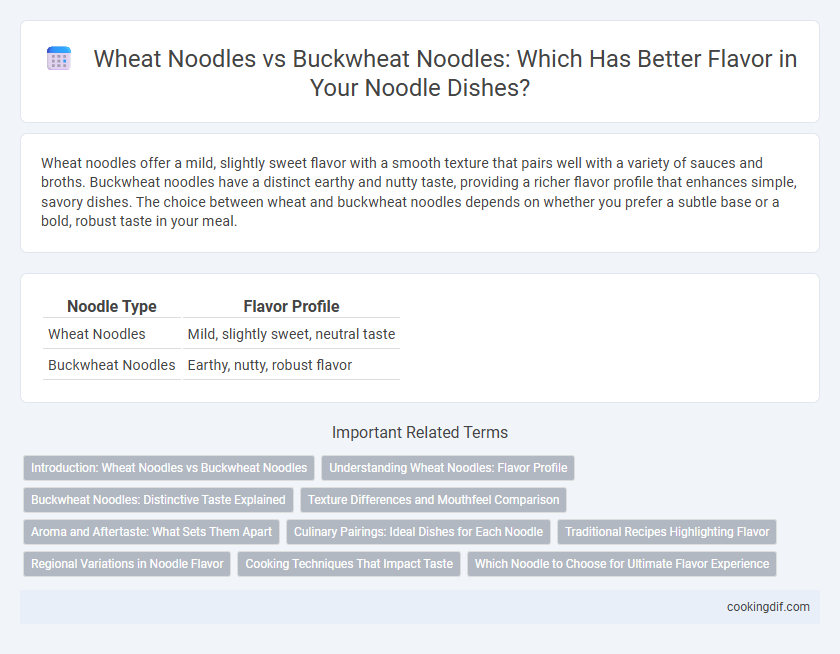Wheat noodles offer a mild, slightly sweet flavor with a smooth texture that pairs well with a variety of sauces and broths. Buckwheat noodles have a distinct earthy and nutty taste, providing a richer flavor profile that enhances simple, savory dishes. The choice between wheat and buckwheat noodles depends on whether you prefer a subtle base or a bold, robust taste in your meal.
Table of Comparison
| Noodle Type | Flavor Profile |
|---|---|
| Wheat Noodles | Mild, slightly sweet, neutral taste |
| Buckwheat Noodles | Earthy, nutty, robust flavor |
Introduction: Wheat Noodles vs Buckwheat Noodles
Wheat noodles offer a chewy texture with a mild, slightly sweet flavor profile, making them versatile for a wide range of dishes. Buckwheat noodles, known as soba in Japanese cuisine, provide an earthy, nutty taste and a firmer bite, appealing to those seeking a distinctive flavor. Both types vary in nutritional content, with buckwheat noodles typically higher in protein and fiber, catering to health-conscious consumers.
Understanding Wheat Noodles: Flavor Profile
Wheat noodles offer a mild, slightly sweet flavor with a chewy texture that easily absorbs sauces, making them versatile in various dishes. Their gluten content provides elasticity, resulting in a satisfying bite that contrasts with the denser, earthier taste of buckwheat noodles. Understanding wheat noodles' subtle profile highlights their ability to balance and complement bold flavors without overpowering the dish.
Buckwheat Noodles: Distinctive Taste Explained
Buckwheat noodles offer a distinctive earthy and slightly nutty flavor that sets them apart from the milder taste of wheat noodles. Rich in rutin and antioxidants, buckwheat imparts a robust, complex profile that enhances traditional dishes like soba. Their unique flavor also pairs well with savory broths and dipping sauces, making them a versatile choice for those seeking a bold noodle experience.
Texture Differences and Mouthfeel Comparison
Wheat noodles offer a smooth, elastic texture with a chewy bite, delivering a familiar mouthfeel that holds sauces well. Buckwheat noodles, known for their slightly coarse and grainy texture, provide a firmer bite and a nuttier, earthier flavor profile. The contrast in mouthfeel highlights wheat noodles as tender and pliable, while buckwheat noodles boast a heartier, more robust sensory experience.
Aroma and Aftertaste: What Sets Them Apart
Wheat noodles offer a mild aroma with a subtle wheaty fragrance that enhances versatility in various dishes, while buckwheat noodles possess a distinctive, earthy aroma rich in nutty undertones. The aftertaste of wheat noodles remains clean and light, complementing savory flavors without overpowering them, whereas buckwheat noodles leave a lingering, robust aftertaste emblematic of their bold, slightly bitter profile. These sensory differences in aroma and aftertaste make wheat noodles ideal for delicate broths and sauces, while buckwheat noodles excel in dishes seeking a pronounced, hearty flavor experience.
Culinary Pairings: Ideal Dishes for Each Noodle
Wheat noodles, with their mild flavor and chewy texture, pair exceptionally well with rich sauces like soy-based stir-fries, creamy Alfredo, or spicy peanut sauces, making them ideal for diverse Asian and Italian dishes. Buckwheat noodles offer a distinctive earthy and nutty flavor that complements lighter broths, sesame dressings, and fresh vegetables, commonly enhancing Japanese soba salads and cold noodle dishes. Selecting between wheat and buckwheat noodles depends on the desired flavor profile and the culinary context of the dish.
Traditional Recipes Highlighting Flavor
Wheat noodles offer a mild, chewy texture that absorbs sauces well, making them ideal for classic dishes like ramen and lo mein where a balanced flavor is essential. Buckwheat noodles, known as soba, provide a distinct earthy, nutty taste that adds depth to traditional Japanese recipes such as zaru soba and tempura soba. Traditional recipes highlight wheat noodles for their versatility and buckwheat noodles for their unique aromatic profile, enhancing the authenticity and flavor complexity of regional cuisines.
Regional Variations in Noodle Flavor
Wheat noodles, common in East Asian cuisines like Chinese and Japanese, offer a mild, slightly sweet flavor that pairs well with rich broths and savory sauces. Buckwheat noodles, exemplified by Japanese soba and Korean memil guksu, provide a nutty, earthy taste that reflects regional agricultural practices and climate conditions. These distinct flavor profiles highlight the cultural and environmental influences shaping noodle preferences across different regions.
Cooking Techniques That Impact Taste
Wheat noodles offer a chewy texture and mild flavor that absorbs sauces well, making them ideal for stir-frying and boiling techniques that enhance their elasticity and taste. Buckwheat noodles, known for their nutty aroma and slightly grainy texture, benefit from gentle boiling to preserve their distinct flavor and prevent bitterness. Proper cooking techniques such as precise timing and water temperature control are crucial to maximizing the unique taste profiles of both wheat and buckwheat noodles.
Which Noodle to Choose for Ultimate Flavor Experience
Wheat noodles offer a mild, chewy texture that absorbs sauces well, making them ideal for rich, flavorful dishes like ramen or lo mein. Buckwheat noodles, or soba, have a nutty, earthy flavor that provides a distinct taste profile, perfect for cold dishes or light broths. Choosing between wheat and buckwheat noodles depends on whether you prefer a subtle base for bold sauces or a robust, standalone flavor enhancing your meal.
Wheat noodles vs buckwheat noodles for flavor Infographic

 cookingdif.com
cookingdif.com